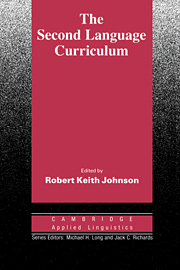Book contents
- Frontmatter
- Contents
- Contributors
- Series editors' preface
- Acknowledgements
- Overview
- I 1 CURRICULUM OVERVIEW
- I 2 CURRICULUM PLANNING
- II ENDS/MEANS SPECIFICATION
- III PROGRAMME IMPLEMENTATION
- Chapter 7 Faculty development for language programs
- Chapter 8 The evolution of a teacher training programme
- Chapter 9 Appropriate design: the internal organisation of course units
- Chapter 10 Beyond language learning: perspectives on materials design
- IV CLASSROOM IMPLEMENTATION
- V EVALUATION
- Bibliography
- Index
Chapter 7 - Faculty development for language programs
Published online by Cambridge University Press: 05 October 2012
- Frontmatter
- Contents
- Contributors
- Series editors' preface
- Acknowledgements
- Overview
- I 1 CURRICULUM OVERVIEW
- I 2 CURRICULUM PLANNING
- II ENDS/MEANS SPECIFICATION
- III PROGRAMME IMPLEMENTATION
- Chapter 7 Faculty development for language programs
- Chapter 8 The evolution of a teacher training programme
- Chapter 9 Appropriate design: the internal organisation of course units
- Chapter 10 Beyond language learning: perspectives on materials design
- IV CLASSROOM IMPLEMENTATION
- V EVALUATION
- Bibliography
- Index
Summary
Introduction
The heart of every educational enterprise, the force driving the whole enterprise towards its educational aims, is the teaching faculty. Hence, the nature of the faculty, in both its overall composition and the characteristics of its individual members, to a large extent determines the unique character of any language program. As stated by Eskey (1982), in a brief article on the faculty of intensive ESL programs: ‘The single most important feature of any program … is the teaching faculty. … [G]ood teachers make good programs…’ (p. 39).
In what follows, the nature and development of language program faculties is explored in detail. The concept of faculty development is taken to embrace three areas:
The Education and Training of Language Teachers
The Organization of a Language Program Faculty
The Evolution and Growth of a Language Program Faculty
Figure 1 Aspects of faculty development
Each of these aspects of faculty development is taken up in turn. The first of these topics addresses both pre-service and in-service teacher preparation and training. In this section, a number of different approaches to teacher training are outlined, and a general model for conceptualizing the teaching act is proposed. The second section includes discussion of faculty structure in the larger organizational context of a language program. Under the third heading are included matters of faculty evaluation, supervision, continuing education and professional growth. In this section, a comprehensive model of the teaching cycle from the perspective of long-term faculty development is proposed.
- Type
- Chapter
- Information
- The Second Language Curriculum , pp. 91 - 110Publisher: Cambridge University PressPrint publication year: 1989
- 8
- Cited by



